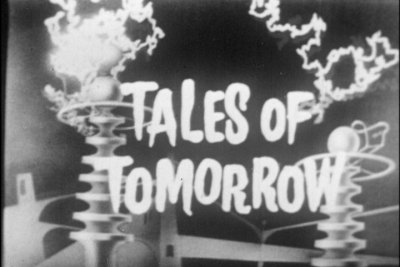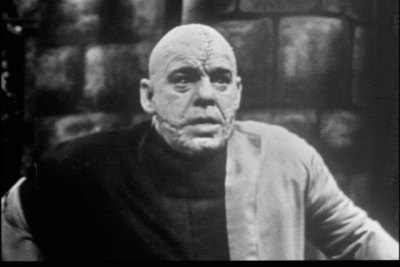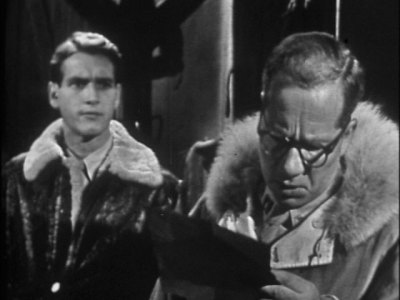| Reviews & Columns |
|
Reviews DVD TV on DVD Blu-ray 4K UHD International DVDs In Theaters Reviews by Studio Video Games Features Collector Series DVDs Easter Egg Database Interviews DVD Talk Radio Feature Articles Columns Anime Talk DVD Savant Horror DVDs The M.O.D. Squad Art House HD Talk Silent DVD
|
DVD Talk Forum |
|
|
| Resources |
|
DVD Price Search Customer Service #'s RCE Info Links |
|
Columns
|
|
|
Tales of Tomorrow: Collection One
1950 and '51 were important years for science fiction. Influential films were released that set the tone and standard for decades to come. In 1950 Destination Moon whose high production values and scientific plausibility started the SF craze. The following year saw The Day the Earth Stood Still and The Thing from Another Planet. These films with their benevolent alien race and extraterrestrial monster, respectively, cast the mold for movie aliens. With the burgeoning popularity of science fiction movies, it was only natural that the new industry of TV would climb aboard.
So 1951 saw the creation of the first anthology based science fiction show, Tales of Tomorrow. The forerunner of such shows as Twilight Zone and Outer Limits, Tales of Tomorrow is hardly remembered today. That's a shame because many of the episodes are very good with excellent scripts and some fine acting. Image Entertainment has released a two DVD set containing 13 episodes from this influential show.

At the time of Tales of Tomorrow's creation, science fiction was looked on by TV executives as only suitable for children. Space Patrol and Tom Corbet, Space Cadet were the norm for SF shows. Taking its cue from the movies, Tales of Tomorrow strived to be more sophisticated and thought out than that afternoon children's fare. Many of the episodes had actual SF writers like Theodore Sturgeon and Arthur C. Clarke penning the teleplays and the show adapted works by Fredric Brown and Cyril Kornbluth. This show was unlike any other program airing at the time. It treated speculative fiction as an entertaining genre that adults could enjoy. It didn't talk down to its audience, and the endings weren't always happy.
The thirteen episodes contained in this set are all from the first season (or two) and presented in chronological order, though there are some gaps in the run. This show was broadcast live, and it is filled with small errors that one associates with having to get it right the first time. People stumble over their lines at times and bump into the cardboard sets, but these goofs are minor for the most part (with one notable exception that I'll discuss in a bit.)
The shows themselves were constrained by the limits of live TV, a tight production schedule, and a tight budget. There are very few special effects in the show, and a lot of the props are reused. (The alien machinery that appears in the first episode, Verdict From Space, also doubles as equipment in Dr. Frankenstein's lab.) With the small number of sets and few actors, (usually one star and four or five supporting characters) the stories themselves have the feel of one act plays more than movies. While the reality of live TV did hamper the productions, the creators were able to work around these problems to produce a quality show.
To get around the inability to create special effects, most of the stories had a contemporary setting. There weren't any bug-eyed monsters lumbering around the sets or alien landscapes, rather the stories usually dealt with present day people put into extraordinary circumstances. This was actually quite effective, and most of the stories come off quite well.
In another compromise due to technical constraints, much of the violence and horrific parts of the show take place off camera. While this sounds like a way to save money, and it certainly was, it probably improved the quality of the show. Given the state of special effects at the time, any fantastic elements that they might show would certainly look silly and out of place. Instead they leave these to the viewers imagination, which will most certainly come up with something more interesting than the SFX department would.

There were many interesting shows included on in this set. While none of them are as good as the best episodes of Twilight Zone or Outer Limits, they are still some very good programs, especially for fans of early science fiction. The highlight of the set for me was finally being able to see Lon Chaney's appearance on the show in their adaptation of Frankenstein. Chaney played the monster, of course, and was drinking heavily at the time. Rumor has it that he'd mosey on over to the bar between takes and during breaks, and became quite inebriated. When it came time to actually broadcast the show, Chaney was under the impression that they were just doing a dress rehearsal. When it came time for the monster to run amok, Chaney would pick up the break away props, brandish them menacingly, and then carefully put them down before miming their destruction. This story has been written up in several books and articles about Chaney, and finally getting to see this episode was a treat. It actually wasn't as bad as it is usually described. Chaney is usually described as drunkenly staggering about the stage, but it seemed more like his interpretation of the monster to me. While the lack of breaking the props is evident, it actually doesn't really ruin the production. I think the reason the episode doesn't succeed is more because they tried to fit the whole thing into a half hour show rather than Chaney's acting.
One of the more interesting episodes is Ice From Space. A test rocket lands on a military base in the desert. Inside there is a chunk of ice that emits a freezing cold. The ice start to cool down the base, and soon the temperature of the surrounding area is below zero. As time goes on, the area effected grows larger and larger. This show had some good acting, including the first TV appearance of a very young Paul Newman.

Tales of Tomorrow never really caught on, though it lasted two seasons. One of the problems is that, being an anthology show there wasn't a regular cast of characters to draw viewers in week after week. This would be solved in later years by creating a host to introduce the tales, but that hadn't been considered yet. Another factor against the show was that not every episode had a happy ending. I found it surprising how many time the world was destroyed in this series. The critics were against it too, with the New York Times TV critic describing one episode as "indescribably trash and totally bereft of any dramatic worth."
When viewed today this show still holds up to the test of time. These episodes are fun to watch, with solid stories and some interesting situations. Though some of the acting is stilted, and the production values aren't high, this first TV science fiction anthology is well worth watching.
The DVD:
These thirteen episodes are presented on two DVDs that come in a single width double Amaray case. There is an insert with cast and crew credits and a brief description of each episode.
Audio:
Two channel mono was about average for an unrestored early 50's TV show. There was some distortion and cracking, but it wasn't very bad. The sound was very flat of course, but you could generally hear the dialog without any problem. There were a couple of episodes were an actor's phoney accent would make it difficult to understand his lines, but this is more of the actor's fault than the DVDs.
Video:
The full frame video varied from show to show, but was generally very soft. Since these shows were broadcast live, they were preserved by videotaping a monitor of the program as it was being aired. (This means that commercials are included a lot of the time too.) With the state of technology in 1951, it is easy too realize that defects were going to creep in. There was a lot of blooming and grain, and the lines were soft. Most of the images were just a little on the blurry side. Having said that, the picture to most of these shows are good taking their age and origin into consideration, and some are very good. Generally they picture improves as the series progresses. Definitely a watchable show, no one should let the less than perfect picture prevent them from obtaining this set.
Extras:
There are no extras included with this set.
Final Thoughts:
This ground breaking TV show lead the way for other SF anthology programs like Science Fiction Theater and The Twilight Zone. The stories are very good overall making this just a fun show to watch. I hope that Image continues to release shows in this series. The case proclaims that this is "Collection One of 1st Season Shows" so hopefully collection two will be out before too long. Even with the audio and video showing their age, this set gets a high recommendation.
|
| Popular Reviews |
| Sponsored Links |
|
|
| Sponsored Links |
|
|
| Release List | Reviews | Shop | Newsletter | Forum | DVD Giveaways | Blu-Ray | Advertise |
|
Copyright 2024 DVDTalk.com All Rights Reserved. Legal Info, Privacy Policy, Terms of Use,
Manage Preferences,
Your Privacy Choices | |||||||














